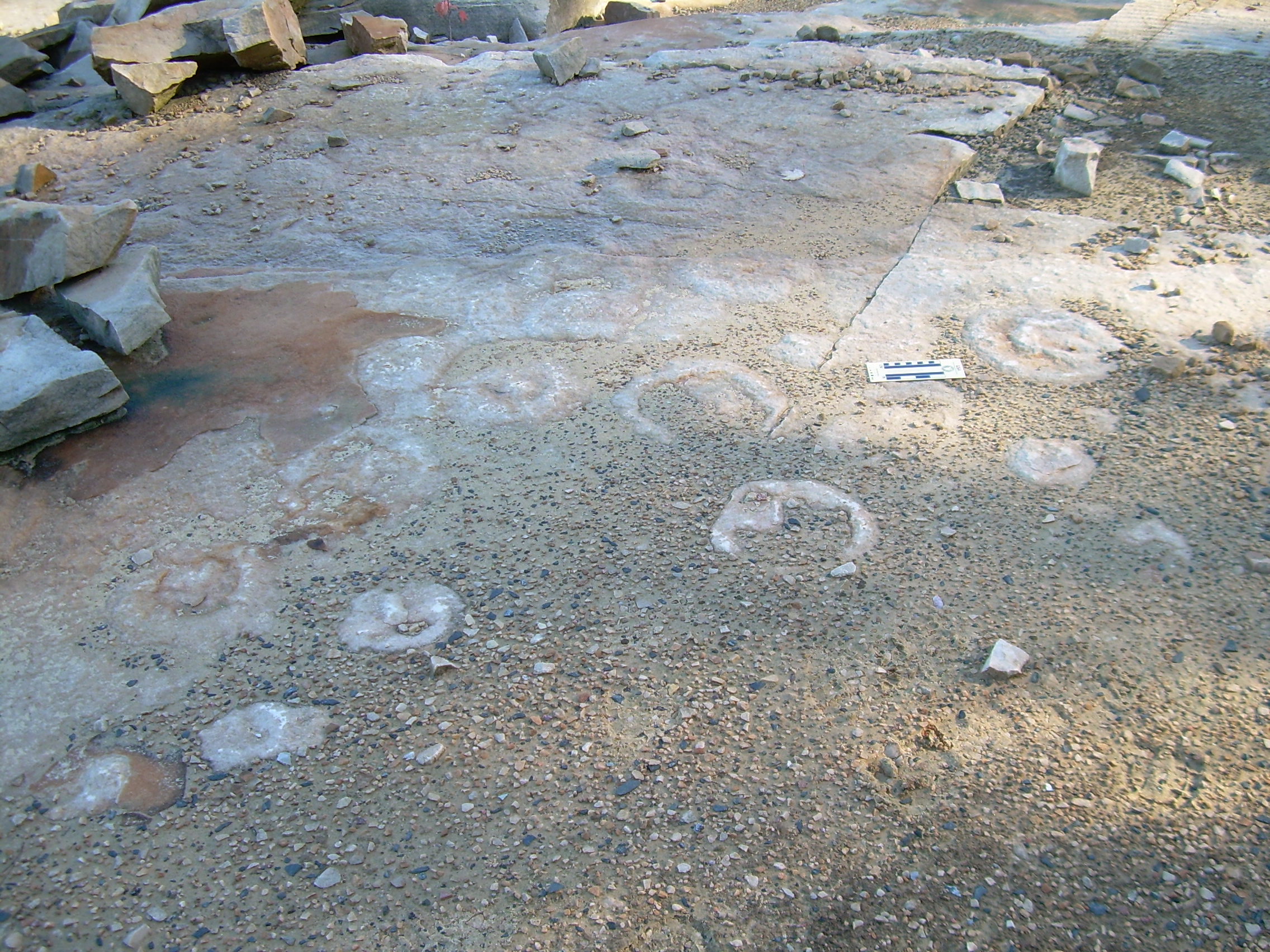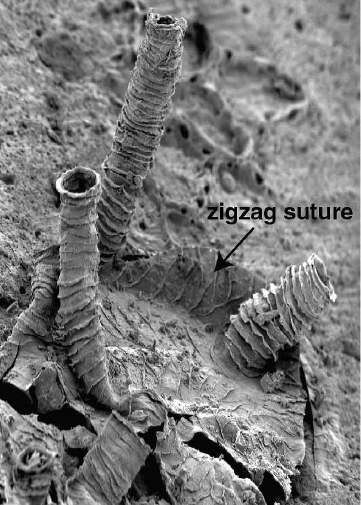|
Paleontology In Wisconsin
Paleontology in Wisconsin refers to paleontological research occurring within or conducted by people from the United States, U.S. state of Wisconsin. The state has fossils from the Precambrian, much of the Paleozoic, some parts of the Mesozoic and the later part of the Cenozoic. Most of the Paleozoic rocks are marine in origin. Because of the thick blanket of Pleistocene glacial sediment that covers the rock strata in most of the state, Wisconsin’s fossil record is relatively sparse. In spite of this, certain Wisconsin paleontological occurrences provide exceptional insights concerning the history and diversity of life on Earth. Prehistory Precambrian Many metamorphic, igneous and sedimentary rock units are exposed in the north-central part of Wisconsin. Although they are mostly barren of fossils, some of the sedimentary ones contain stromatolites. Cambrian Exposures of Cambrian rock units, many of which are fossiliferous, occur in western and central Wisconsin, especiall ... [...More Info...] [...Related Items...] OR: [Wikipedia] [Google] [Baidu] |
Map Of USA WI
A map is a symbolic depiction of interrelationships, commonly spatial, between things within a space. A map may be annotated with text and graphics. Like any graphic, a map may be fixed to paper or other durable media, or may be displayed on a transitory medium such as a computer screen. Some maps change interactively. Although maps are commonly used to depict geography, geographic elements, they may represent any space, real or fictional. The subject being mapped may be two-dimensional such as Earth's surface, three-dimensional such as Earth's interior, or from an abstract space of any dimension. Maps of geographic territory have a very long tradition and have existed from ancient times. The word "map" comes from the , wherein ''mappa'' meant 'napkin' or 'cloth' and ''mundi'' 'of the world'. Thus, "map" became a shortened term referring to a flat representation of Earth's surface. History Maps have been one of the most important human inventions for millennia, allowin ... [...More Info...] [...Related Items...] OR: [Wikipedia] [Google] [Baidu] |
Conulariids
Conulariida are an extinct group of medusozoan cnidarians known from fossils spanning from the latest Ediacaran up until the Late Triassic. They are almost exclusively known from their hard external structures (alternatively referred to as a theca, periderm or test), which were pyramidal in shape and made up of numerous lamellae (thin layers). They are thought to have been sessile animals that grew with the narrower tip anchored to the seafloor, with the wider end bearing an array of tentacles used to ensnare prey. Structure The conulariids are fossils preserved as shell-like structures made up of rows of calcium phosphate rods, resembling an ice-cream cone with fourfold symmetry, usually four prominently-grooved corners. New rods were added as the organism grew in length; the rod-based growth falsely gives the fossils a segmented appearance. Exceptional soft-part preservation has revealed that soft tentacles protruded from the wider end of the cone, and a holdfast from the poi ... [...More Info...] [...Related Items...] OR: [Wikipedia] [Google] [Baidu] |
Trilobite
Trilobites (; meaning "three-lobed entities") are extinction, extinct marine arthropods that form the class (biology), class Trilobita. One of the earliest groups of arthropods to appear in the fossil record, trilobites were among the most successful of all early animals, existing in oceans for almost 270million years, with over 22,000 species having been described. Because trilobites had wide diversity and an easily fossilized mineralised exoskeleton made of calcite, they left an extensive fossil record. The study of their fossils has facilitated important contributions to biostratigraphy, paleontology, evolution, evolutionary biology, and plate tectonics. Trilobites are placed within the clade Artiopoda, which includes many organisms that are morphologically similar to trilobites, but are largely unmineralised. The relationship of Artiopoda to other arthropods is uncertain. Trilobites evolved into many ecological niches; some moved over the seabed as predators, scavengers, or ... [...More Info...] [...Related Items...] OR: [Wikipedia] [Google] [Baidu] |
Scyphozoans
The Scyphozoa are an exclusively marine class of the phylum Cnidaria, referred to as the true jellyfish (or "true jellies"). The class name Scyphozoa comes from the Greek word '' skyphos'' (), denoting a kind of drinking cup and alluding to the cup shape of the organism. Scyphozoans have existed from the earliest Cambrian to the present. Biology Most species of Scyphozoa have two life-history phases, including the planktonic medusa or polyp form, which is most evident in the warm summer months, and an inconspicuous, but longer-lived, bottom-dwelling polyp, which seasonally gives rise to new medusae. Most of the large, often colorful, and conspicuous jellyfish found in coastal waters throughout the world are Scyphozoa. They typically range from in diameter, but the largest species, ''Cyanea capillata'' can reach across. Scyphomedusae are found throughout the world's oceans, from the surface to great depths; no Scyphozoa occur in freshwater (or on land). As medusae, they eat ... [...More Info...] [...Related Items...] OR: [Wikipedia] [Google] [Baidu] |
Euthycarcinoid
Euthycarcinoidea are an enigmatic group of extinct, possibly amphibious arthropods that ranged from Cambrian to Triassic times. Fossils are known from Europe, North America, Argentina, Australia, and Antarctica. Description The euthycarcinoid body was divided into a cephalon (head), preabdomen, and postabdomen. The cephalon consisted of two segments and included mandibles, antennae and presumed eyes. The preabdomen consisted of five to fourteen tergites, each having up to three somites. Each somite had in turn a pair of uniramous, segmented legs. The postabdomen was limbless and consisted of up to six segments and a terminal tail spine. Affinities Due to its particular combination of characteristics, the position of the Euthycarcinoidea within the Arthropoda has been ambiguous; previous authors have allied euthycarcinoids with crustaceans (interpreted as copepods, branchiopods, or an independent group), with trilobites, or the merostomatans ( horseshoe crabs and sea scorpi ... [...More Info...] [...Related Items...] OR: [Wikipedia] [Google] [Baidu] |
Jellyfish
Jellyfish, also known as sea jellies or simply jellies, are the #Life cycle, medusa-phase of certain gelatinous members of the subphylum Medusozoa, which is a major part of the phylum Cnidaria. Jellyfish are mainly free-swimming marine animals, although a few are anchored to the seabed by stalks rather than being motile. They are made of an umbrella-shaped main body made of mesoglea, known as the ''bell'', and a collection of trailing tentacles on the underside. Via pulsating contractions, the bell can provide propulsion for animal locomotion, locomotion through open water. The tentacles are armed with cnidocyte, stinging cells and may be used to capture prey or to defend against predators. Jellyfish have a complex biological life cycle, life cycle, and the medusa is normally the sexual phase, which produces planula larvae. These then disperse widely and enter a sedentary #Life cycle, polyp phase which may include asexual budding before reaching sexual maturity. Jellyfish ... [...More Info...] [...Related Items...] OR: [Wikipedia] [Google] [Baidu] |
Blackberry Hill
Blackberry Hill is a Lagerstätten, Konservat-Lagerstätte of Cambrian age located within the Elk Mound Group in Marathon County, Wisconsin, Marathon County, Wisconsin.Braddy, Gass & Gass, 2022 It is found in a series of quarries and outcrops that are notable for their large concentration of exceptionally preserved trace fossils in Cambrian tidal flats. One quarry in particular also has the distinction of preserving some of the first land animals. These are preserved as three-dimensional casts, which is unusual for Cambrian animals that are only lightly biomineralized.Collette and Hagadorn, 2010 Additionally, Blackberry Hill is the first occurrence recognized to include Cambrian mass strandings of scyphozoans (jellyfish).Getty and Hagadorn, 2008 Age and stratigraphic placement The strata at Blackberry Hill are known to belong to the Elk Mound Group;Schieber et al., 2007 however, the lack of good stratigraphic markers (i.e., index fossils) in some Blackberry Hill localities, cou ... [...More Info...] [...Related Items...] OR: [Wikipedia] [Google] [Baidu] |
Aglaspidid
Aglaspidida is an extinct order of marine arthropods known from fossils spanning the Middle Cambrian to the Upper Ordovician. Initially considered chelicerates, modern anatomical comparisons demonstrate that the aglaspidids cannot be accommodated within this group, and that they lie instead within the Artiopoda, thus placing them closer to the trilobites, being placed in the artiopod subgroup Vicissicaudata. With 38 known valid species as of 2017, they represent one of the most diverse groups of early Paleozoic arthropods, after trilobites.Lerosey-Aubril, R., Ortega-Hernández, J., Van Roy, P., Zhu, X., (2017)The Aglaspidida: a poorly-known, yet important order of early Palaeozoic arthropods ''International Workshop on Evolution of Cambrian Arthropods - Taxonomy, Ontogeny and Phylogeny''. 1-6 Sep. 2017, Xian, China. Aglaspidid fossils are found in North America (United States and Canada), Europe, Australia, and China. Description The exoskeletons of aglaspidids have frequently ... [...More Info...] [...Related Items...] OR: [Wikipedia] [Google] [Baidu] |
Conodont
Conodonts, are an extinct group of marine jawless vertebrates belonging to the class Conodonta (from Ancient Greek κῶνος (''kōnos''), meaning " cone", and ὀδούς (''odoús''), meaning "tooth"). They are primarily known from their hard, mineralised tooth-like structures called "conodont elements" that in life were present in the oral cavity and used to process food. Rare soft tissue remains suggest that they had elongate eel-like bodies with large eyes. Conodonts were a long-lasting group with over 300 million years of existence from the Cambrian (over 500 million years ago) to the beginning of the Jurassic (around 200 million years ago). Conodont elements are highly distinctive to particular species and are widely used in biostratigraphy as indicative of particular periods of geological time. Discovery and understanding of conodonts The teeth-like fossils of the conodont were first discovered by Heinz Christian Pander and the results published in Saint Petersburg, ... [...More Info...] [...Related Items...] OR: [Wikipedia] [Google] [Baidu] |
Graptolites
Graptolites are a group of colonial animals, members of the subclass Graptolithina within the class Pterobranchia. These filter-feeding organisms are known chiefly from fossils found from the Middle Cambrian (Miaolingian, Wuliuan) through the Lower Carboniferous ( Mississippian). A possible early graptolite, ''Chaunograptus'', is known from the Middle Cambrian. Recent analyses have favored the idea that the living pterobranch '' Rhabdopleura'' represents an extant graptolite which diverged from the rest of the group in the Cambrian. Fossil graptolites and ''Rhabdopleura'' share a colony structure of interconnected zooids housed in organic tubes (theca) which have a basic structure of stacked half-rings (fuselli). Most extinct graptolites belong to two major orders: the bush-like sessile Dendroidea and the planktonic, free-floating Graptoloidea. These orders most likely evolved from encrusting pterobranchs similar to ''Rhabdopleura''. Due to their widespread abundance, pla ... [...More Info...] [...Related Items...] OR: [Wikipedia] [Google] [Baidu] |
Trilobites
Trilobites (; meaning "three-lobed entities") are extinct marine arthropods that form the class Trilobita. One of the earliest groups of arthropods to appear in the fossil record, trilobites were among the most successful of all early animals, existing in oceans for almost 270million years, with over 22,000 species having been described. Because trilobites had wide diversity and an easily fossilized mineralised exoskeleton made of calcite, they left an extensive fossil record. The study of their fossils has facilitated important contributions to biostratigraphy, paleontology, evolutionary biology, and plate tectonics. Trilobites are placed within the clade Artiopoda, which includes many organisms that are morphologically similar to trilobites, but are largely unmineralised. The relationship of Artiopoda to other arthropods is uncertain. Trilobites evolved into many ecological niches; some moved over the seabed as predators, scavengers, or filter feeders, and some swam, feeding o ... [...More Info...] [...Related Items...] OR: [Wikipedia] [Google] [Baidu] |







